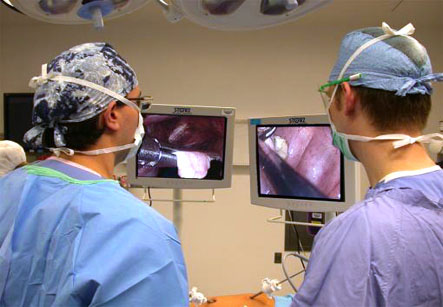Pelvic Laparoscopy
Introduction
Pelvic laparoscopy is surgery to examine pelvic organs with the help of a viewing tool called as laparoscope. The surgery is also used to treat certain diseases of the pelvic organs.
Procedure:
The patient is given general anesthesia, which means patient is in deep sleep and pain-free during the procedure. The doctor makes a half-inch surgical incision in the skin below the belly button. Carbon dioxide gas is pumped into the abdomen through this incision to help the surgeon see the organs more easily.
The laparoscope is an instrument that looks like a small telescope with a light and a video camera, is inserted so the doctor can view the area.
Other instruments may be inserted through other small cuts in the lower abdomen. Under the guidance of video monitor, the doctor may:
• Take out tissue samples (biopsy)
• Look around and diagnose the cause of any related symptoms
• Can perform removal of scar tissue or other abnormal tissue, such as from foci of endometriosis
We have all the information you need about public and private clinics and hospitals that provide gynecological treatment in Iran

• Repair or remove part or all of the damaged ovaries or tubes
• Repair or remove parts of the uterus
• Perform other surgical procedures such as appendectomy, removal of lymph nodes
After the laparoscopy, the carbon dioxide gas is released, and the surgeon closes the incisions with stitches.
The average time required for surgery depends on the procedure performed.
Benefits:
Laparoscopy uses a smaller surgical incision than open surgery. Therefore, laparoscopy often involves:
1. Shorter hospital stay
2. Quicker recovery
3. Minimal anesthesia
4. Less blood loss
5. Small external scars
6. Mild to moderate postoperative pain
Indications:
Pelvic laparoscopy is used both for diagnosis and treatment. It may be performed in cases of:
1. An abnormal pelvic mass or ovarian cyst found on pelvic ultrasound
2. Cancer of organs such as ovary, endometrium, or cervix, for detecting spread or removing nearby lymph nodes or tissue
3. Chronic pelvic pain, if no other cause has been found
4. Ectopic pregnancy
5. Endometriosis
6. Infertility
7. Sudden, severe pelvic pain
A pelvic laparascopy may also be done to:
1. Perform hysterectomy (removal of uterus)
2. Remove uterine fibroids (myomectomy)
3. Sterilization by tubal ligation
Risks
General anesthesia poses the risk of reactions to medications and breathing problems. Risks for any pelvic surgery include:
1. Bleeding
2. Infection
3. Blood clots in the leg or pelvic veins travelling to the lungs.
4. Damage to nearby organs and tissues
5. Heart problem
Before the Procedure
Inform the doctor if there is possibility of being pregnant
Inform about any drugs being take, even herbs or supplements bought without a prescription
During the days before surgery:
• Patient should stop taking aspirin, ibuprofen, warfarin, and any other drugs that make it hard for the blood to clot.
• Ask the doctor or nurse about which medicines are still to be taken on the day of surgery.
• Smoking should be stopped.
• Arrange for someone to drive you home after surgery.
On the day of your surgery:
• Patient is asked not to drink or eat anything after midnight the night before the surgery, or 8 hours before the surgery.
• Take the drugs the doctor or nurse told you to take with a small sip of water.
• A consent form is signed by the patient regarding permission for surgery.
After the Procedure
Patient is shifted to recovery area after waking up from the anesthesia.
Often, patient is able to go home the same day as the procedure. Sometimes, an overnight stay is required.
Results:
The gas pumped into the abdomen may cause abdominal discomfort for 1 – 2 days after the procedure. Some patients can feel neck and shoulder pain for several days after a laparoscopy as the carbon dioxide gas irritates the diaphragm. As the gas is absorbed this pain will go away. Lying down can help to decrease the pain.
General anesthesia poses the risk of reactions to medications and breathing problems.
The doctor may give a prescription for pain medicine or can suggest an over-the-counter pain medicine that can be taken.
Normal activities may be resumed in fewer than 2 days. Depending on what procedure is performed, sexual activities can be begun again as soon as the bleeding (if there is any) has stopped. Do not lift anything over 10 pounds for 3 weeks after surgery to decrease the risk of getting a hernia in the incisions.